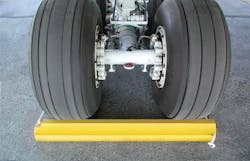Pushing back from Logan International Airport this week, I – and all the other passengers on the crowded Airbus 320 – felt the unmistakable jolts, sounds and vibrations of the aircraft running over something.
Sure enough, as the aircraft completed its 90-degree turn to prepare for departure under its own power, I could plainly see the chocks that had been run over by the aircraft as it was being pushed off the gate.
No damage to the chocks – they’re pretty hardy, of course. And there did not appear to be damage to the aircraft – although you don’t want to run over too many objects and damage the tires as that can cause potentially significant safety problems
But that’s not the focus of my concern. When chocks are left behind it indicates a rushed or sloppy (or, even worse, rushed and sloppy) operation. Likely, rushing to get a delayed flight out as soon as possible affected the operation here as there had been a 10-minute maintenance delay just before pushback.
So how do you avoid these types of mistakes? While leaving chocks behind is certainly not one of the most dangerous things that can happen on an airport ramp – it is an indicator that people under pressure may not provide their best performances. And that can lead to incidences and accidents.





